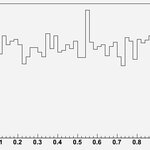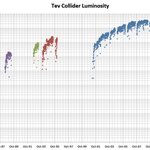Physics

At PhyStat 2011, currently being held at CERN, talks are informal and the atmosphere is friendly, but I have heard very few jokes from the participants so far. Just a minute ago I witnessed what might be a pretty strong bid at the best joke of the conference.
Kyle Cranmer was showing results of very CPU-intensive calculations of renormalization-group equations used to derive measurable parameters of Supersymmetry from the value of basic parameters at a high-energy scale. He was mentioning that the original calculation used to take 720 CPU-days, but that they had found a series of shortcuts…

Looks like particle physicists have finally digested the food of Christmas break by now. Just as I was reviewing a new paper on the arxiv on the Tevatron Higgs limits, I ran into another hot preprint, titled "The Reactor Antineutrino Anomaly".
The article re-evaluates the flux of antineutrinos from reactors with new spectra of decays from heavy nuclei, finding that the flux is larger than previously estimated by about 3 percent, at all reactor experiments. This drives the former ratio of observed by predicted flux from 0.979+-0.029 to 0.937+-0.027: this seemingly small difference has a huge…
While listening to highly interesting talks on cutting-edge statistical issues at PHYSTAT 2011, I have casually been reading this morning a paper recently posted on the arxiv, which was pointed out to me by a Cypriot friend, Alex (thanks, Alex!).
The authors (J. Baglio,
A. Djouadi,
S. Ferrag,
R.M. Godbole) move a direct attack to the results produced by the CDF and DZERO experiments on the search for the Standard Model Higgs boson, claiming that they are basically wrong; that is: they do not explicitly say so, but on the other hand they strongly argue that the limits were obtained with what…

Remember the neat little experiment whose result may be counter intuitive to some of those who embrace the “all bodies fall the same way inside earth’s gravity” ‘doctrine’ without quite understanding it? Here it is again - if the video should not come up fast enough, here it is on the MIT website.
It is a simple set-up and great idea for a project involving children. Older ones may be able to calculate the required lengths of the wooden angle's arms and the required position of the cup.
I challenged readers to come up with a short and philosophical reason for why the end of the arm reaches…

When physicists working in a collaboration want to publish the observation of a new effect in the data, they need to first convince their peer that what they are observing is real, and not the product of a weird fluctuation.
Statistical fluctuations are everywhere, and they sometimes do produce weird results. We are only human, and when facing unlikely fluctuations we are invariably tempted to interpret them as the manifestation of something new and unknown.
Because our weakness is well understood not only by psychologists but also by men of Science ;-) , there are remedies, though.…

Thanks to the Tevatron Facebook account manager, R.M. (Ron, tell me if I can disclose your identity here), I can offer to you today an exceptional plot of historical significance.
Before I paste below the plot in question, let me discuss what it is about. The Tevatron collider has operated since October 1985 -about a couple of geological eras back, in particle physics terms. The W and Z bosons were newborn babies back then, the top quark was thought to have a mass in the 30-50 GeV ballpark, and, to paraphrase the Rolling Stones, "Carlo Rubbia raged and the bodies stunk".
Quite a long road it…

This just in. The Tevatron collider, proud and glory of Fermilab, the leading high-energy lab in the US, will stop collider operations for good at the end of FY2011. This means that CDF and DZERO will collect roughly 1800 additional inverse picobarns, reaching a total of about 10 inverse femtobarns of collected data (the delivered and acquired integrated luminosities differ due to downtimes as well as voluntary dead time of the triggering system).
I think 10 inverse femtobarns of data are not different from 16 -the amount that the Tevatron could end up producing if it were run until 2014. Of…

New important information on high-energy particle physics has recently been released by the CDF experiment, one of the two detectors scrutinizing the 2-TeV proton-antiproton collisions copiously produced by the Fermilab Tevatron collider located near Batavia, Illinois (see aerial view of the site below). The CDF experiment has ruled out the existence of so-called "Z' bosons" (particles extraneous to the Standard Model which are predicted by a number of new physics models) for Z' masses below one Tera-electronvolt.
In other words, if such particles exist they must be more massive than a…

I am sorry, this is not yet supposed to be published, but I also do not want to delete the content. This is work in progress, somehow the option to keep an "yet unpublished version" disappeared. You are thus welcome to follow my editing process (the version you read now is already somewhat complete, but still not well organized).
In part one I promised to show that the trilobite molecule does not look at all like a trilobite but rather as a pine cone. I had some pictures, I wanted to upload them for later editing - but here it all became public.
Here is the Physics News original message with…

Ok, I promise - my next post here will be a highly interesting article on the status of searches for new heavy Z bosons. In the meantime, however, I allow myself another "personal" post. After an evaluation of 2010 from the point of view of research activities and blog activities, I wish to report here on a few things I look forward to in 2011.
In March a very well-known science popularization magazine will feature an article of mine. Actually, two articles -they had asked me for a 2500 words piece but got something like 7000, and they seemed to like the whole set. I cannot disclose the…